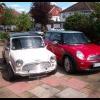
KEG 77 in Japan where it was exported in 1996.
The oldest Mini (Motorsport magazine August 1989)
The Survivor
Author: William Kimberley
Like Hitler’s personal car, there are plenty of “first” Minis around. Sometimes they are a prize to be won in a national newspaper and sometimes they are museum objects, but Motor Sport can claim categorically to have seen the earliest Mini there is, and it is still in private ownership.
The claim is relatively easy to substantiate, since documents form the British Leyland Heritage Trust verify the claim. Registered KEG 77, the chassis number of this Austin Mini is A/A2S7/103. That number is so unremarkable that when the present owner acquired the car he had no idea just how significant it was. He knew it was an early example when he rescued it form the scrapyard, but it was not until reading an article in the Mini Club magazine that he discovered it was much more.
Chassis No 1 belongs to the Heritage Trust at Syon Park, this being the first of the Morris Minis which went down the line at Cowley on May 8, 1959. But the featured car here emerged from the Longbridge line on May 4. It was the third one built, but Austin chassis 101 was broken up while chassis 102 was given to Donald Healey by Issigonis, but not as a Mini for it had been utterly transformed into something else. Chassis 103, however, found
its way out to be sold to a customer through a dealer in Peterborough.
Unlike 621 AOK, the Heritage Trust car, everything about KEG 77 is original, including the engine, gearbox, bodyshell and even the sub-frame. Few sections of the metalwork have needed replacing, but some repair work has been necessary. Rather than use plastic filler, all rust spots have been dealt with by leading, the traditional way of dealing with rotten metal.
There are literally thousands of differences between this car and later production models, as well as the early Morris Minis. Close inspection shows it to be of a very different construction, and virtually every pressing was unique to it including the floor, sides, bulkhead and roof. The doors and bonnet, however, remained unaltered.
The owner and restorer is an insurance agent called David Worrow. He is one of those fiendish enthusiasts who almost gives perfection a bad name, taking it to extremes when restoring a car as a means of relaxation form the rigours of high finance.
Such is David’s single mindedness that in bringing the car back to full glory he would not consider using any part that could not have been originally fitted. An indicator lens, for instance, that had been manufactured after the summer of 1959 would be rejected. He has taken the trouble to check that the reference number of each part corresponds to the month of manufacture of the car or, at worst, shows it to have been manufactured a few months beforehand, so that part and car could possibly have come together in the factory.
David Worrow is an E-type Jaguar enthusiast, but follow his acquisition of KEG 77 he has made himself an expert on the early Mini, partly through hours of studying parts books, a particularly useful source for finding out when parts were changed.
An examination of the car when it was still in pieces showed that it was fitted with dozens of A35 parts which were later replaced by items made specifically for the Mini. The rear brake drums, for example were obviously lifted from the parts bin as the car trundled its way down the line. Other A35 parts were modified for the Mini, such as he wiper motor which is straight out of the little Austin but modified to fit the newer car.
As one delves into the history of this car, it becomes more and more fascinating to examine how original design thoughts were modified as it became older, either for production purposes or for reason of cost. The sub-frame on Worrow’s car was bolted on, but since it was found that the threads kept crossing when the car was in full production, the assembly was changed to studs. Today, needless to say, KEG 77 has the sub-frame with threads.
Unique to this Mini are the handbrake cables, the single-piece radiator, cowl and bracket, the early Lucas distributor and old style dynamo and its rocker box. The end plate on the transmission was subsequently changed as was the pressure-fed clutch centre.
More than the metalwork and mechanicals, it was the interior which presented problems during the restoration, for it had been stripped for use in club rallying. With David’s fetish for getting things right, it took hours of painstaking research to ensure that all the correct trim was used. Although the front legs of the front seats were uniquely welded to the floor, there were parts missing, and since each seat was made up of four different panels it took Worrow some considerable time to repair them.
In early Minis, the only dial was the speedometer. Early versions had a silver dial with a red pointer, but this was subsequently changed to a silver dial with clear pointer. David’s car has a grey face with red pointer, which fortunately was not missing.
Completed in time for its thirtieth birthday, David Worrow’s Mini looks as good as new, sitting on its original specification tyres and as identical as can be to the state in which it left the factory. It has been started and driven since its restoration, but such is its importance that it will rarely be seen on the road; it will take pride of place in Worrow’s private collection of E-types and other fine cars.
For those lucky enough to see it, it will be a living reminder of the time when the British small car was a world-beater: desirable and even chic. WPK
https://www.motorspo...8/the-survivor/













